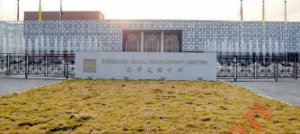
Pak China Friendship Center, Islamabad
The Pakistan-China Friendship Center, located in Islamabad, stands as a physical embodiment of the deep and enduring friendship between Pakistan and China. Established as a testament to the strong bilateral relations between the two nations, this center serves as a hub for cultural exchange, diplomatic engagement, and the promotion of people-to-people ties. In this article, we delve into the significance, history, and multifaceted functions of the Pakistan-China Friendship Center.
A Symbol of Diplomatic Friendship
The Pakistan-China Friendship Center, often referred to as the PCFC, was inaugurated on December 18, 2005, by the then-Pakistani President General Pervez Musharraf and the Chinese Premier Wen Jiabao. This significant event marked the culmination of years of collaboration and diplomacy between the two nations, highlighting the importance of their strategic partnership.
Architectural Splendor
The PCFC is renowned for its architectural beauty and grandeur. The building itself is an exemplary blend of traditional and modern design elements, showcasing the rich cultural heritage of Pakistan and China. With its majestic dome, intricately designed corridors, and lush gardens, the center provides a serene environment for various events and activities.
Functions and Significance
The Pakistan-China Friendship Center serves as a versatile venue for a wide range of functions and events, reflecting the depth and breadth of the bilateral relationship between the two nations:
Cultural Exchange: The PCFC is a hub for cultural exchange activities, including art exhibitions, music concerts, dance performances, and traditional craft displays. These events celebrate the cultural diversity and heritage of both countries and promote mutual understanding.
Diplomatic Engagement: The center hosts high-level diplomatic meetings, conferences, and seminars. It provides a neutral and welcoming space for discussions on regional and global issues, further cementing Pakistan and China’s collaborative efforts on the international stage.
Education and Awareness: The Pakistan-China Friendship Center plays a crucial role in educating the public about the multifaceted nature of the Pakistan-China relationship. It hosts educational programs, lectures, and exhibitions to raise awareness about the cultural, economic, and strategic ties between the two nations.
Trade and Economic Initiatives: The PCFC serves as a platform for trade exhibitions and business conferences, facilitating economic cooperation between Pakistan and China. It has played a vital role in promoting the China-Pakistan Economic Corridor (CPEC), one of the most significant infrastructure projects in the region.
Celebrating Milestones: The center is often used to celebrate important milestones in Pakistan-China relations, such as anniversaries and visits by high-ranking officials. These events underscore the historical significance and ongoing relevance of the friendship between the two nations.
The Future of Friendship
The Pakistan-China Friendship Center continues to play a vital role in strengthening the enduring bond between Pakistan and China. As both nations deepen their cooperation across various sectors, the center remains a symbol of their commitment to working together for mutual benefit and regional stability.
Looking ahead, the PCFC is poised to continue serving as a dynamic hub for cultural exchange, diplomacy, and economic collaboration. It will play a pivotal role in fostering greater understanding between the people of Pakistan and China, ultimately contributing to the growth and prosperity of both nations and the broader region.
In conclusion, the Pakistan-China Friendship Center in Islamabad is more than just a building; it represents the enduring friendship and strategic partnership between two nations. It stands as a testament to the shared values, common goals, and deep mutual respect that define the relationship between Pakistan and China. As this friendship continues to evolve and strengthen, the center will remain a symbol of unity and cooperation between these two great nations.

